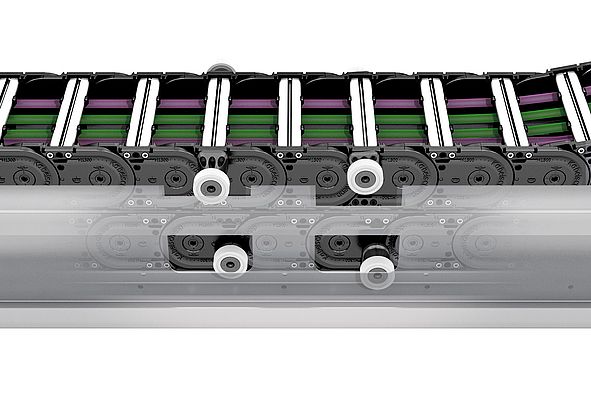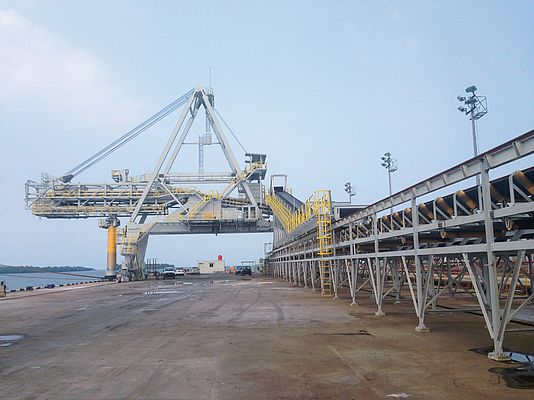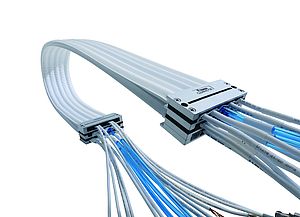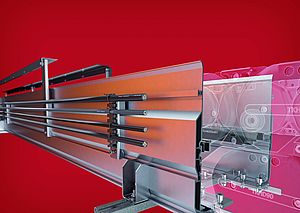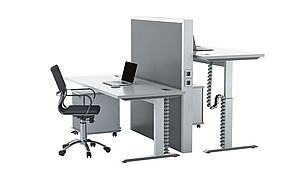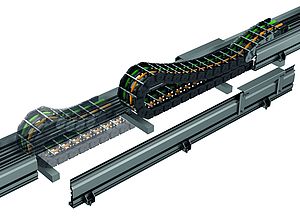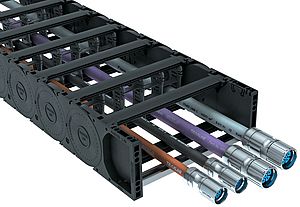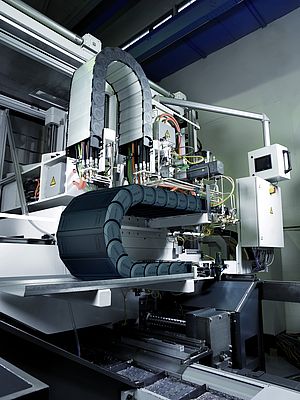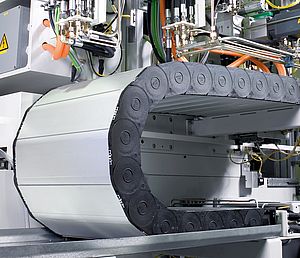A robust cable carrier including a cable package and with a particularly long travel length for a new crane system in the company’s own port: this has been the tender from the Indonesian fertilizer manufacturer Pupuk Kaltim. TSUBAKI KABELSCHLEPP has been able to win the bid and to successfully implement the project with an international team. The basis for this RSC system is a MC1300 cable carrier equipped with TRAXLINE drag chain cables.
“One of the decisive aspects for the customer has been that TSUBAKI KABELSCHLEPP is able to supply cable carrier and cables from one source,” explains Dipl.-Ing. Winfried Sambale, Product Specialist for Cables at Kabelschlepp. “Only few suppliers are able to offer this, particularly as this project required the use of special medium voltage cables”. These are continuous bending hi-flex 10,000 Volt drag chain cables, which are especially designed for long travel lengths. Weight and capacity of the cables are optimized: compared to 1,000 Volt cables, the active power cable is only a few millimeters thicker at the same weight, but it can transmit up to 10 times the electric power.
TSUBAKI KABELSCHLEPP has quickly found the right cable carrier for the high performance cable package: “Based on the required travel length in combination with the associated cable package, we have immediately decided to use a rolling chain application,” explains Thorsten Serapinas, Manager Project Engineering at TSUBAKI KABELSCHLEPP GmbH. “260 meters is one of the longer travel lengths we have ever implemented with a rolling system.”
One of the reasons why this project is outstanding is that KABELSCHLEPP has been able to implement it successfully and cost-efficiently with an international team cooperating across great distance. The project has been planned and managed from the headquarters in Germany while the TSUBAKI team in Singapore has supported the coordination. For cost reasons, all steel components have been manufactured locally in compliance with defined quality standards. Only the cable carrier itself has been supplied from Germany in separate parts and in pre-assembled roller segments. The Indonesian project partner ATI installed the system, which was then accepted and released by TSUBAKI KABELSCHLEPP in September 2015.
Since then, the RSC system has been running successfully at the Pupuk Kaltim port on the island of Borneo. It is installed on the transverse axis of a new crane system used for loading and unloading ships. Serapinas explains, “Based on the required travel length in conjunction with the associated cable package we have immediately decided in favor of a rolling chain application.” Roller supported chains are an ideal solution for high additional loads and long travel lengths. In contrast to the combined gliding/rolling systems already available in the market, the upper run of the TSUBAKI KABELSCHLEPP RSC system never touches the lower run. The upper run of the cable carrier runs on a guide profile with maintenance-free ball bearing rollers. As this requires only low pull/push forces, wear within the connections of the cable carrier is reduced to a minimum. This excludes unwanted lengthening of the overall system and additional load on the guided cables is avoided. Due to the low pull/push forces the required driving force is reduced and thereby the power of the drives is scaled down as well. All RSC systems are based on proven standard cable carriers from TSUBAKI KABELSCHLEPP, in this case a MC1300 – a multi-variable cable carrier designed especially for crane applications. One of its main features is the extremely high stability created by seawater resistant aluminum stays.
To ensure particularly high quality, TSUBAKI KABELSCHLEPP continuously tests systems at Kabelschlepp’s own outdoor test facility. Travel lengths of more than 100 meters and travel speeds of up to 5 m/s can be simulated fully automatically. Several test tracks allow simultaneous testing of both gliding systems and RSC solutions –in 24/7 testing cycles and even under extreme external conditions such as rough winter weather, direct UV radiation or heavy rainfall.


